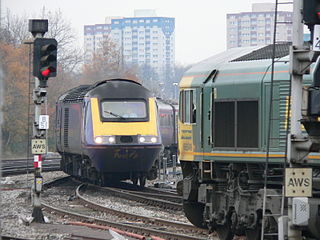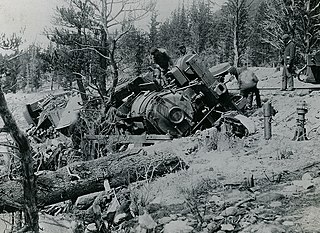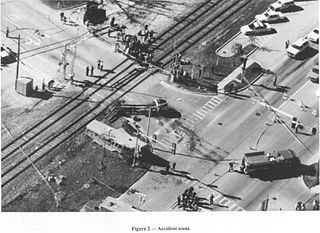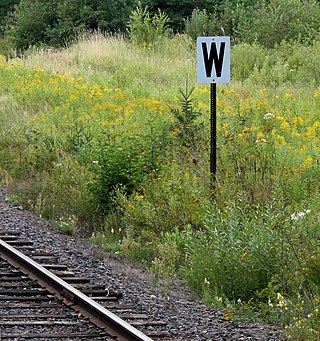
A railway signal is a visual display device that conveys instructions or provides warning of instructions regarding the driver’s authority to proceed. The driver interprets the signal's indication and acts accordingly. Typically, a signal might inform the driver of the speed at which the train may safely proceed or it may instruct the driver to stop.

Railway signalling (BE), also called railroad signaling (AE), is a system used to control the movement of railway traffic. Trains move on fixed rails, making them uniquely susceptible to collision. This susceptibility is exacerbated by the enormous weight and inertia of a train, which makes it difficult to quickly stop when encountering an obstacle. In the UK, the Regulation of Railways Act 1889 introduced a series of requirements on matters such as the implementation of interlocked block signalling and other safety measures as a direct result of the Armagh rail disaster in that year.

A railway track or railroad track, also known as a train track or permanent way, is the structure on a railway or railroad consisting of the rails, fasteners, railroad ties and ballast, plus the underlying subgrade. It enables trains to move by providing a dependable surface for their wheels to roll upon. Early tracks were constructed with wooden or cast iron rails, and wooden or stone sleepers; since the 1870s, rails have almost universally been made from steel.
Rail terminology is a form of technical terminology. The difference between the American term railroad and the international term railway is the most significant difference in rail terminology. These and other terms have often originated from the parallel development of rail transport systems in different parts of the world. In English-speaking countries outside the United Kingdom, a mixture of US and UK terms may exist.

In rail transport, a derailment occurs when a rail vehicle such as a train comes off its rails. Although many derailments are minor, all result in temporary disruption of the proper operation of the railway system and they are a potentially serious hazard.
A track warrant is a set of instructions issued to a train crew authorizing specific train movements. The system is widely used in North America. The warrant is issued by the train dispatcher and delivered to the train crew via radio. The train crew copies the instructions onto a pre-printed paper form and reads back the warrant to ensure that nothing was misunderstood.

Cab signaling is a railway safety system that communicates track status and condition information to the cab, crew compartment or driver's compartment of a locomotive, railcar or multiple unit. The information is continually updated giving an easy to read display to the train driver or engine driver.

A crossbuck is a traffic sign used to indicate a level railway crossing. It is composed of two slats of wood or metal of equal length, fastened together on a pole in a saltire formation. Crossbucks are sometimes supplemented by electrical warnings of flashing lights, a bell, or a boom barrier that descends to block the road and prevent traffic from crossing the tracks.

A double-track railway usually involves running one track in each direction, compared to a single-track railway where trains in both directions share the same track.

The 1995 Fox River Grove bus–train collision was a grade crossing collision that killed seven students riding aboard a school bus in Fox River Grove, Illinois, on the morning of October 25, 1995. The school bus, driven by a substitute driver, was stopped at a traffic light with the rearmost portion extending onto a portion of the railroad tracks when it was struck by a Metra Union Pacific / Northwest Line train en route to Chicago.
Standards for North American railroad signaling in the United States are issued by the Association of American Railroads (AAR), which is a trade association of the railroads of Canada, the US, and Mexico. Their system is loosely based on practices developed in the United Kingdom during the early years of railway development. However, North American practice diverged from that of the United Kingdom due to different operating conditions and economic factors between the two regions. In Canada, the Canadian Rail Operating Rules (CROR) are approved by the Minister of Transport under the authority of the Railway Safety Act. Each railway company or transit authority in Canada issues its own CROR rulebook with special instructions peculiar to each individual property. Among the distinctions are:
Direct traffic control (DTC) is a system for authorizing track occupancy used on some railroads instead of or in addition to signals. It is known as "direct" traffic control because the train dispatcher gives track authority directly to the train crew via radio, as opposed to through wayside personnel via telephone or telegraph, as in train orders.

In rail transport, a whistle post or whistle board, is a sign marking a location where a train driver is required to sound the horn or whistle.

Positive train control (PTC) is a family of automatic train protection systems deployed in the United States. Most of the United States' national rail network mileage has a form of PTC. These systems are generally designed to check that trains are moving safely and to stop them when they are not.

Automatic block signaling (ABS), spelled automatic block signalling or called track circuit block (TCB) in the UK, is a railroad communications system that consists of a series of signals that divide a railway line into a series of sections, called blocks. The system controls the movement of trains between the blocks using automatic signals. ABS operation is designed to allow trains operating in the same direction to follow each other in a safe manner without risk of rear-end collision.
The American Railway Engineering and Maintenance-of-Way Association (AREMA) is a North American railway industry group. It publishes recommended practices for the design, construction and maintenance of railway infrastructure, which are used in the United States and Canada.
Swiss railway signalling describes the railway signalling systems used in Switzerland by the different railway companies. There are two main types of signal, used up to 160 km/h, above which speed cab signalling is required.
Designs of level crossings, where railway lines cross roads or other paths, vary country-to-country.











